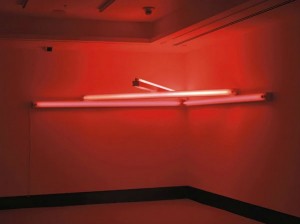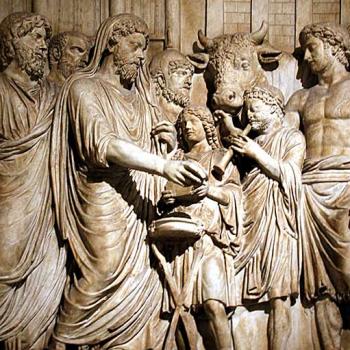
While walking with my wife Wendy the other night, our conversation took an interesting turn. She has been reading Patti Smith’s memoir, Just Kids, and told me about how, in the early 70s, Smith and artist Robert Mapplethorpe would spend long evenings at Max’s Kansas City hoping to connect with Andy Warhol. For some reason, Smith thought it worth mentioning that they waited under the red glow of a light sculpture commemorating the bloodshed of the Vietnam war.
My wife is a good storyteller and the mention of a light artist jogged my memory — I was pleased to remember a New York Times piece about Dan Flavin, who turned out to be the creator of that sculpture in the back room of Max’s. The article detailed the challenges of preserving and presenting Flavin’s work: after his death and with the increasing value of his sculptures, Flavin’s off-the-shelf practicality often gave way to meticulous attempts to preserve his ephemeral creations.
What happens when a Flavin bulb burns out? Can you replace it with a bulb from the corner hardware store? Leave it dark? Or must you only purchase hand-crafted copies of the original bulbs that are officially licensed by the Flavin estate?
As the conversation wandered, my wife raised questions about the nature of certain religious experiences. Delusional? Bullshit? Philosopher Harry Frankfurt would say intentionally ignoring the truth of a claim and instead focusing solely on the desired affects of that claim is the very definition of bullshit. Considered as such, a religious pitch is no different than that of a used car salesman who will do whatever it takes to put you in that car today.
Do we partake in religion because of how it makes us feel — the emotions, the social comfort, the tradition — without care for the substance, or lack thereof, behind it all?
For me, a helpful metaphor for this kind of religious questioning is found in Patti Smith’s anecdote and Dan Flavin’s artwork.
When is a light bulb in a corner just a light bulb in a corner? When is it (or, for that matter, when does it become) a work of art?
Are we all waiting in the back room of an iconic nightclub under a museum-destined rosy glow for an appearance by one of the great artists of the 20th century? Or are we waiting, night after night, in a dingy bar that’s illumed by a buzzing fluorescent bulb, for an appearance by a manipulative narcissist who might never show up?
“Since it makes no factual difference to you and you can’t prove the question either way, which story do you prefer?”, Piscine Patel, a practicing Muslim, Christian and Hindu, asks in Life of Pi. In Piscine’s view, God is whatever you prefer. Given his pluralistic embrace of major religions, he might say that the nature of these questions isn’t either/or: it is a bulb in the corner and it is a meaningful work of art.
The Flavin bulb captures something important, but to further tease apart the metaphor risks fracturing an already fragile construct. Sometimes, rather than fretting about meaning and borrowing the trouble of a burned-out bulb, perhaps we should simply appreciate the light—or the lack thereof.
 Dan Wilkinson
Dan Wilkinson
Dan is a writer, graphic designer and IT specialist. He lives in Montana, is married and has two cats. He blogs at CoolingTwilight.com.












